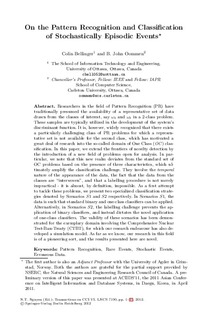| dc.contributor.author | Bellinger, Colin | |
| dc.contributor.author | Oommen, B. John | |
| dc.date.accessioned | 2012-06-07T10:12:07Z | |
| dc.date.available | 2012-06-07T10:12:07Z | |
| dc.date.issued | 2012 | |
| dc.identifier.citation | Bellinger, C., & Oommen, B. (2012). On the pattern recognition and classification of stochastically episodic events. In N. Nguyen (Ed.), Transactions on Compuational Collective Intelligence VI (Vol. 7190, pp. 1-35): Springer. | no_NO |
| dc.identifier.isbn | 978-3-642-29355-9 | |
| dc.identifier.uri | http://hdl.handle.net/11250/137946 | |
| dc.description | Published version of a chapter published in the book: Transactions on Compuational Collective Intelligence VI. Also available from the publisher at: http://dx.doi.org/10.1007/978-3-642-29356-6_1 | no_NO |
| dc.description.abstract | Researchers in the field of Pattern Recognition (PR) have traditionally presumed the availability of a representative set of data drawn from the classes of interest, say ω 1 and ω 2 in a 2-class problem. These samples are typically utilized in the development of the system’s discriminant function. It is, however, widely recognized that there exists a particularly challenging class of PR problems for which a representative set is not available for the second class, which has motivated a great deal of research into the so-called domain of One Class ( OC ) classification. In this paper, we extend the frontiers of novelty detection by the introduction of a new field of problems open for analysis. In particular, we note that this new realm deviates from the standard set of OC problems based on the presence of three characteristics, which ultimately amplify the classification challenge. They involve the temporal nature of the appearance of the data, the fact that the data from the classes are “interwoven”, and that a labelling procedure is not merely impractical - it is almost, by definition, impossible. As a first attempt to tackle these problems, we present two specialized classification strategies denoted by Scenarios S 1 and S 2 respectively. In Scenarios S 1, the data is such that standard binary and one-class classifiers can be applied. Alternatively, in Scenarios S 2, the labelling challenge prevents the application of binary classifiers, and instead dictates the novel application of one-class classifiers. The validity of these scenarios has been demonstrated for the exemplary domain involving the Comprehensive Nuclear Test-Ban-Treaty (CTBT), for which our research endeavour has also developed a simulation model. As far as we know, our research in this field is of a pioneering sort, and the results presented here are novel. | no_NO |
| dc.language.iso | eng | no_NO |
| dc.publisher | Springer | no_NO |
| dc.relation.ispartofseries | Lecture Notes in Computer Science; 7190; | |
| dc.subject | Pattern Recognition | no_NO |
| dc.subject | rare events | no_NO |
| dc.subject | stochastic events | no_NO |
| dc.subject | erroneous data | no_NO |
| dc.title | On the pattern recognition and classification of stochastically episodic events | no_NO |
| dc.type | Chapter | no_NO |
| dc.type | Peer reviewed | no_NO |
| dc.subject.nsi | VDP::Mathematics and natural science: 400::Information and communication science: 420::Knowledge based systems: 425 | no_NO |
| dc.source.pagenumber | 1-35 | no_NO |
